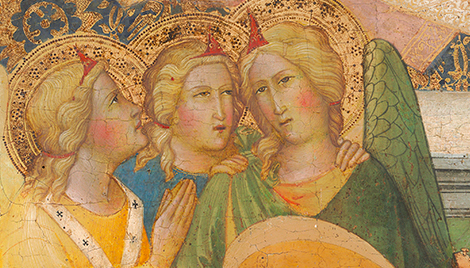Summer 2019 Two-week Introduction to Practical Conservation
In 2019 the University of Delaware was awarded a grant for $33,400 to support an intensive two-week conservation education and training program for four advanced students enrolled in Historically Black Colleges and Universities (HBCUs). The following description of the conservation program has been taken directly from the final report submitted by the University of Delaware.
The TIP-C group of 2019 poses in front of the World War I diorama with their recent paper marbling projects on the table in front of them. From Left to Right, standing, Dr. Joyce Hill Stoner, instructor; Shon Walker (Spelman College); Phebe Pankey (Winston Salem State University); Dr. Caryl McFarlane (HBCU Alliance outreach project coordinator); Te’Arra Stewart (University of Arkansas, Pine Bluff); Seated: Meghan Abercrombie, teaching assistant (WUDPAC); Torri Richardson (University of Arkansas, Pine Bluff); and Sydney Cole (UD undergrad).
University of Delaware2019 marked the third summer the Two-week Introduction to Practical Conservation (TIP-C) was offered to HBCU students. The program was led by Dr. Joyce Hill Stoner of the Department of Art Conservation, University of Delaware, Dr. Caryl McFarlane of the Alliance of HBCU Museums and Galleries, and Dr. Jontyle Robinson of Tuskegee University and the Alliance of HBCU Museums and Galleries.
The TIP-C program of study included two weeks of experiential learning where students were engaged in the examination, documentation, analysis, treatment, and preventive care of a large diorama from the Tuskegee University collection, entitled World War I. These students were introduced to careers in art conservation as the project aims to build a more diverse and inclusive pipeline for the conservation profession while simultaneously working to preserve the rich cultural treasures held in HBCU museums and galleries.
The TIP-C program was part of the larger Building Diversity in Art Conservation initiative that occurred over the course of three weeks from June 3 - June 21 and also included a one-week Yale HBCU Student and Mentors Institute in Technical Art History (SMITAH).
All four TIP-C participants were selected from the fifteen-student cohort of the Yale SMITAH Program, enabling them to be involved in three continuous weeks of cultural heritage immersion. The four participants chosen were:
Phebe Pankey (Winston Salem State University)
Research topic: James VanDerZee (1886-1983), Harlem Renaissance photographer who photographed the Harlem Hellfighters
Torri Richardson (University of Arkansas at Pine Bluff)
Korean War Scene painting by Jimmie Mosely (1927-1974) owned by the University of Maryland, Eastern Shore
Te'Arra Michelle Stewart (University of Arkansas at Pine Bluff)
Research topic: Harlem Hellfighters (369th Infantry regiment) and the World War I diorama from Tuskegee University’s Legacy Museum
Shon Kacey Walker (Spelman College)
Research topic: Laura Wheeler Waring (1887-1948) and her Portrait of Reverend Irvin Underhill owned by Lincoln University
Dr. Joyce Hill Stoner developed the program’s rigorous two-week, hands-on introduction to art conservation that included topics such as preventive conservation, scientific analysis, and the preservation of cultural heritage more broadly. The four TIP-C students were able to learn about various types of conservation and had the opportunity to learn the techniques introduced during SMITAH through their guided exploration of the Winterthur conservation labs, their assistance in the treatment of the World War I diorama, and their work on a water-damaged painting.
Left: Phebe Pankey uses cosmetic sponges to remove accumulated grime from the World War I diorama depicting Needham Roberts and Henry Johnson, award-winning members of the “Harlem Hellfighters.” Right: Te’Arra Stewart uses solvents and a cotton swab to remove a discolored varnish from a 19th-century portrait
University of DelawareThe program also enabled the students to learn about objects conservation and fiber analysis, create a paint sample, practice consolidation and inpainting, learn paper marbling and photograph process identification, assist in cleaning, and conduct research on some aspect of the diorama.
The students presented their findings to Winterthur staff and University of Delaware faculty and students on the final day of the program. Their presentations were well received, and a representative from the Emerging Conservation Professionals Network (ECPN) attended to greet the students and invite them to participate in ECPN.
The Conservation Treatment of the World War I diorama from Tuskegee University
World War I is one of 33 dioramas made for the American Negro Exposition of 1940. Led by Charles C. Dawson, William E. Scott, and Erik Lindgren, the dioramas created by over 120 African American artisans are now owned by Tuskegee University’s Legacy Museum. This diorama depicts African American honored sergeants, Needham Roberts and Henry Johnson, on the battlefield in what is probably Meuse-Argonne, France, where the 369th Regiment, otherwise known as the Harlem Hellfighters, was known to have primarily fought during World War I.
While working in collaboration with our faculty and Meghan Abercrombie, advanced pre-program Fellow (now a first-year WUDPAC student), the TIP-C students completed the examination and analysis and made significant progress with the cleaning and consolidation of the World War I diorama. Each TIP-C student assisted in the surface cleaning of the ground of the WWI diorama, where most of the dust had collected. Most of the cleaning was focused on the plaster floor of the diorama; figures and other objects were avoided until further analysis could be conducted. The students later assisted Dr. Rosie Grayburn in the X-ray fluorescence analysis of objects within the diorama, including the metal barbed-wire fence, fallen branches, and greenery. The conservation treatment required additional work by University of Delaware conservation students and will be returned to Tuskegee’s Legacy Museum soon. Three other dioramas, previously treated by Winterthur/UD are now on display at the Legacy Museum.
For more information about the creation and conservation of the dioramas, see the video below.



